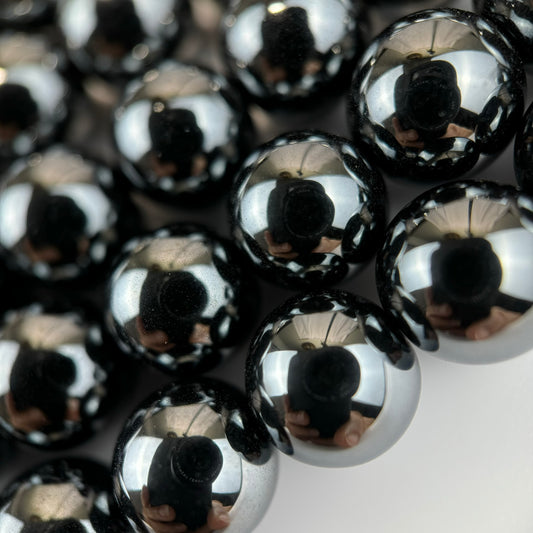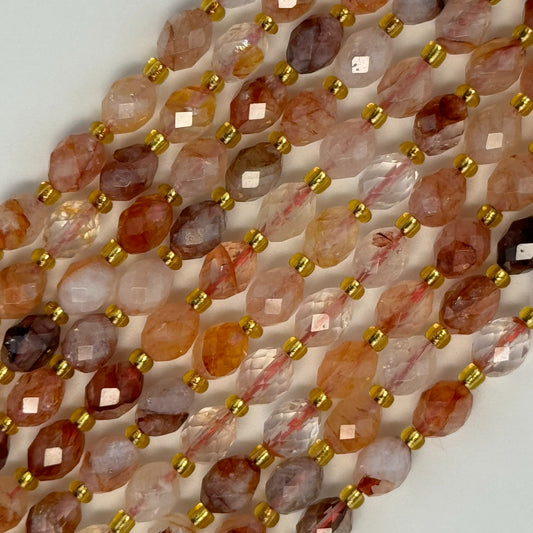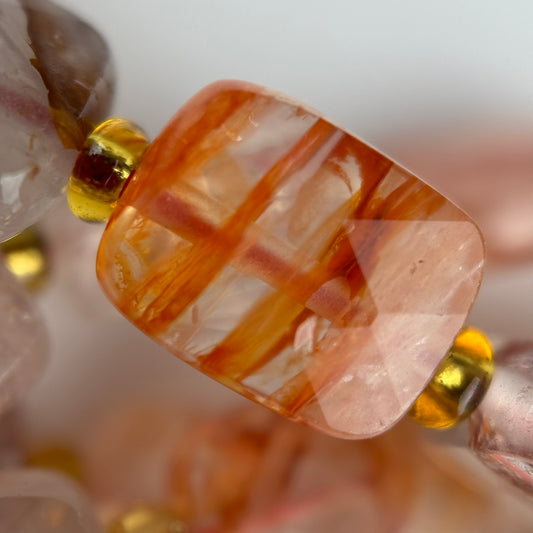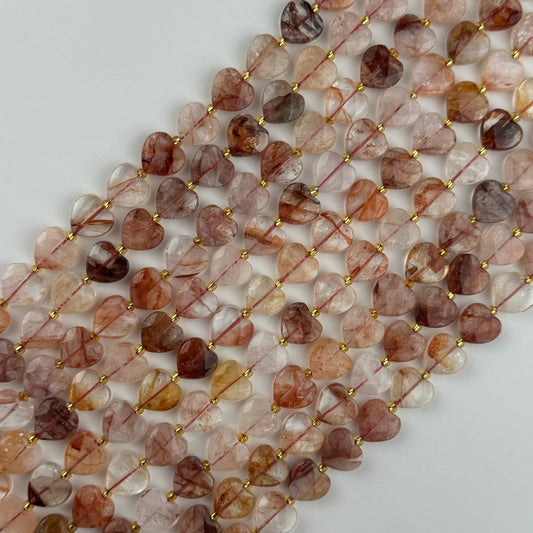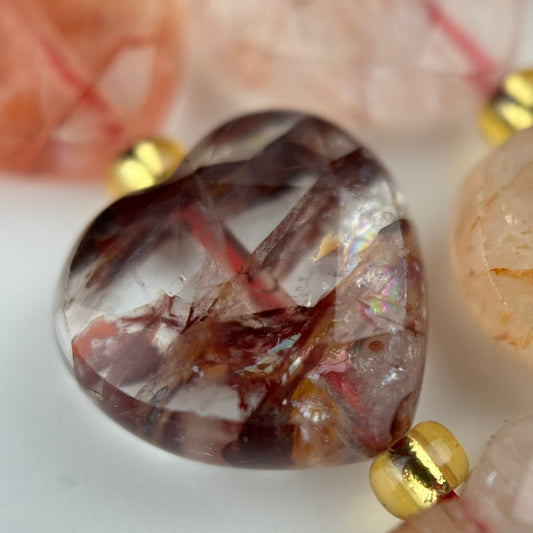Hematite Gemstone Beads
Understanding Hematite Gemstone Beads
Hematite is an iron oxide mineral renowned for its metallic luster and dense black appearance. This heavy, opaque gemstone has been used for thousands of years in jewelry and decorative arts, valued for its striking metallic sheen and grounding properties.
Distinctive Features
- Metallic to submetallic luster
- Dense black coloration with steel-gray undertones
- High specific gravity (5.0-5.3)
- Mohs hardness of 5.5-6.5
- Opaque with occasional red streak
Chemical Composition and Crystal Structure
Hematite consists of iron(III) oxide (Fe2O3) and crystallizes in the trigonal crystal system. Its structure allows for the metallic luster that makes it distinctive among gemstones.
Mineralogical Properties
- Chemical formula: Fe2O3 (iron oxide)
- Crystal system: Trigonal/hexagonal
- Specific gravity: 5.0 to 5.3
- Refractive index: 2.94-3.22
- Streak color: Reddish-brown
Formation Processes and Geological Settings
Hematite forms through various geological processes including precipitation from iron-rich solutions, oxidation of other iron minerals, and metamorphic processes in banded iron formations.
Formation Environments
- Sedimentary deposits in banded iron formations
- Hydrothermal veins with iron-rich solutions
- Oxidation zones above iron ore deposits
- Metamorphic rocks under high pressure
- Volcanic environments with iron-rich magmas
Physical Properties and Characteristics
Hematite's weight and metallic appearance make it immediately recognizable. The stone feels noticeably heavier than most other gemstones of similar size.
Physical Attributes
- Exceptionally high density
- Metallic luster when polished
- Conchoidal to uneven fracture
- No cleavage planes
- Magnetic properties in some varieties
Color and Appearance Variations
While typically black, hematite can display various shades and surface finishes that affect its appearance and use in jewelry.
Color Characteristics
- Primary color: Black with metallic sheen
- Surface colors: Steel-gray, silver-gray
- Polished finish: Highly reflective
- Natural finish: Dull metallic
- Some specimens show iridescence
Cutting and Polishing Techniques
Hematite requires specific cutting and polishing methods to achieve its characteristic high-gloss metallic finish. The stone takes an excellent polish.
Lapidary Methods
- Cabochon cutting for smooth surfaces
- High polish essential for metallic luster
- Various shapes: round, oval, faceted
- Bead drilling requires care
- Surface finishing critical
Hardness and Wear Considerations
With a Mohs hardness of 5.5-6.5, hematite requires careful handling and appropriate settings to prevent damage during wear.
Durability Factors
- Moderate hardness: 5.5-6.5
- Susceptible to scratching
- Can chip if struck
- Protective settings recommended
- Careful storage important
Geographic Sources and Mining
Hematite occurs worldwide, with major deposits in Brazil, Australia, China, and various locations in Europe and North America.
Primary Mining Locations
- Brazil: High-quality gem material
- Australia: Large commercial deposits
- China: Significant production
- United States: Various states
- United Kingdom: Historical sources
Care and Cleaning Methods
Proper maintenance preserves hematite's metallic luster and prevents surface damage. The stone requires gentle cleaning methods.
Maintenance Guidelines
- Clean with soft, damp cloth
- Avoid harsh chemicals
- Dry immediately after cleaning
- Store in soft pouch
- Polish with microfiber cloth
- Protect from impacts
Jewelry Applications and Design
Hematite beads create bold, contemporary jewelry pieces. Their metallic appearance works well in both modern and traditional designs.
Design Applications
- Men's jewelry: bracelets and necklaces
- Contemporary statement pieces
- Combinations with silver metals
- Beaded strands for layering
- Focal beads in mixed designs
- Geometric and minimalist styles
Historical and Cultural Significance
Hematite has been used since ancient times for jewelry, pigments, and decorative purposes, holding cultural significance in many civilizations.
Historical Uses
- Ancient Egyptian jewelry and amulets
- Roman signet rings and seals
- Native American decorative items
- Victorian mourning jewelry
- Modern industrial and artistic uses
Metaphysical Properties and Symbolism
Hematite is associated with grounding, protection, and strength in various metaphysical traditions, adding to its appeal beyond physical beauty.
Symbolic Associations
- Grounding and stability
- Protection from negative energy
- Strength and courage
- Focus and concentration
- Emotional balance
Comparison with Similar Materials
Hematite may be confused with other dark, metallic-looking materials. Understanding distinguishing characteristics aids in identification.
Distinguishing Features
- Higher density than most gemstones
- Reddish streak distinguishes from other black stones
- Metallic luster more pronounced than magnetite
- Non-magnetic (unlike magnetite)
- Heavier than obsidian or onyx
Frequently Asked Questions
What is the chemical formula and crystal structure of Hematite beads?
Hematite has the chemical formula Fe2O3 (iron oxide) and crystallizes in the trigonal crystal system, specifically in the hexagonal scalenohedral class. Its structure consists of iron atoms coordinated with oxygen in an octahedral arrangement, forming dense, compact layers.
What is the Mohs hardness and density of Hematite gemstone beads?
Hematite has a Mohs hardness of 5.5 to 6.5, making it moderately hard but more brittle than many gemstones. Its specific gravity ranges from 5.0 to 5.3, which is significantly higher than most other gemstone beads, giving Hematite beads a substantial weight and metallic feel.
What causes the metallic luster and dark color in Hematite beads?
The metallic luster in Hematite results from its high refractive index (approximately 2.94-3.22) and the way light interacts with its dense, opaque crystal structure. The dark gray to black color comes from the iron content, with trace amounts of titanium or other elements sometimes creating subtle color variations.
How does Hematite differ from other iron oxide minerals like Magnetite?
Hematite (Fe2O3) is non-magnetic and has a higher iron oxidation state than Magnetite (Fe3O4), which is magnetic. Hematite forms in more oxidizing environments, while Magnetite forms under reducing conditions. Hematite also has a higher specific gravity and more pronounced metallic luster.
What are the primary formation environments and geological sources of Hematite?
Hematite forms in sedimentary, metamorphic, and igneous environments. Major sources include Brazil, Australia, China, India, and the Lake Superior region of North America. It often forms as a secondary mineral through the oxidation of iron-rich minerals or as a primary mineral in banded iron formations.
What is the streak test and why is it important for identifying Hematite beads?
The streak test reveals Hematite's true color: when scratched on unglazed porcelain, Hematite produces a characteristic reddish-brown streak, despite its dark gray to black appearance. This test is crucial because Hematite's external color can be misleading, and the streak color is diagnostic for identification.
How does the crystal habit affect the appearance of Hematite beads?
Hematite can form in various habits including botryoidal (grape-like clusters), reniform (kidney-shaped), tabular crystals, or massive forms. Beads are typically cut from massive material, but the internal structure can affect how light reflects, creating subtle variations in the metallic sheen.
What is the relationship between Hematite's opacity and its use in jewelry?
Hematite is completely opaque, which means it doesn't transmit light. This opacity, combined with its metallic luster and dark color, makes it ideal for creating bold, statement jewelry pieces. The lack of transparency also means inclusions are less visible, allowing for more uniform bead appearance.
Can Hematite beads be polished to enhance their metallic luster?
Yes, Hematite takes an excellent polish due to its dense structure and moderate hardness. Polishing enhances the metallic luster and creates a mirror-like surface. However, care must be taken during polishing as Hematite can be brittle and may chip if handled roughly.
What causes Hematite beads to feel heavier than other gemstone beads?
Hematite's high specific gravity (5.0-5.3) makes it significantly denser than most gemstones. For comparison, quartz has a specific gravity of 2.65, meaning Hematite is nearly twice as dense. This density gives Hematite beads their characteristic substantial weight and metallic feel.
How does Hematite's brittleness affect its durability in jewelry applications?
Despite its moderate hardness (5.5-6.5), Hematite is relatively brittle and can chip or fracture if subjected to impact or pressure. Beads should be strung with care, and jewelry designs should minimize points of stress. Protective settings or spacing with softer materials can help prevent damage.
What are the optical properties that distinguish Hematite from similar-looking materials?
Hematite's combination of metallic luster, dark color, reddish-brown streak, high specific gravity (5.0-5.3), and non-magnetic properties distinguish it from similar materials. Its refractive index (2.94-3.22) is also much higher than most gemstones, contributing to its distinctive appearance.
How is Hematite processed and shaped into beads?
Hematite beads are typically cut from massive material using diamond-tipped tools due to the mineral's hardness. The cutting process requires careful handling to prevent fracturing. After shaping, beads are polished using progressively finer abrasives to achieve the characteristic metallic luster.
What environmental factors can affect Hematite beads over time?
Hematite is relatively stable but can be affected by prolonged exposure to acids, which can cause surface etching. High humidity combined with certain chemicals may lead to slight oxidation. However, under normal jewelry-wearing conditions, Hematite beads maintain their appearance well.
What makes Hematite beads suitable for men's jewelry and bold designs?
Hematite's dark color, metallic luster, substantial weight, and bold appearance make it ideal for men's jewelry and statement pieces. Its opacity and uniform color allow for clean, modern designs, while its density gives jewelry a premium, substantial feel that appeals to many wearers.

